With the advent of a novel H1N1 influenza outbreak in spring 2009 and the expectation of a second wave during the 2009–2010 flu season, there has been considerable interest in the use of surgical masks (facemasks) and respirators as infection control measures. Although their appearance is often similar, respirators are designed and engineered for distinctly different functions than surgical masks. The amount of exposure reduction offered by respirators and surgical masks differs. The National Institute for Occupational Safety and Health (NIOSH) and the Centers for Disease Control and Prevention (CDC) recommend the use of a NIOSH-certified N95 or better respirator for the protection of healthcare workers who come in direct contact with patients with H1N1.
The CDC guidance can be found in Interim Guidance on Infection Control Measures for 2009 H1N1 Influenza in Healthcare Settings. In September 2009 the Institute of Medicine released a report “Respiratory Protection for Healthcare Workers in the Workplace Against Novel H1N1 Influenza A” that also recommends N95 respirators for the protection of healthcare workers from H1N1. This blog examines the scientific principles behind the design and performance of surgical masks and respirators. Although these principles apply to all particulate respirators, the discussion presented in this article is focused on the most frequently used respirator in healthcare settings, the N95 filtering facepiece respirator (FFR).
Evolution of Respiratory Protection against Particulate Exposures
Early surgical masks were constructed from layers of cotton gauze. They were first worn by surgery staff in the early 1900s to prevent contamination of open surgical wounds. With time their design, function, and use have expanded. Today surgical masks are worn in a wide range of healthcare settings to protect patients from the wearers’ respiratory emissions. A surgical mask is a loose-fitting, disposable device that prevents the release of potential contaminants from the user into their immediate environment. In the U.S., surgical masks are cleared for marketing by the U.S. Food and Drug Administration (FDA). They may be labeled as surgical, laser, isolation, dental, or medical procedure masks. They may come with or without a face shield. Since OSHA issued the Bloodborne Pathogens Standard (29 CFR 1910.1030) in 1991, surgical masks have been recommended as part of universal precautions to protect the wearer from direct splashes and sprays of infectious blood or body fluids. (The FDA offers further information on surgical masks.)
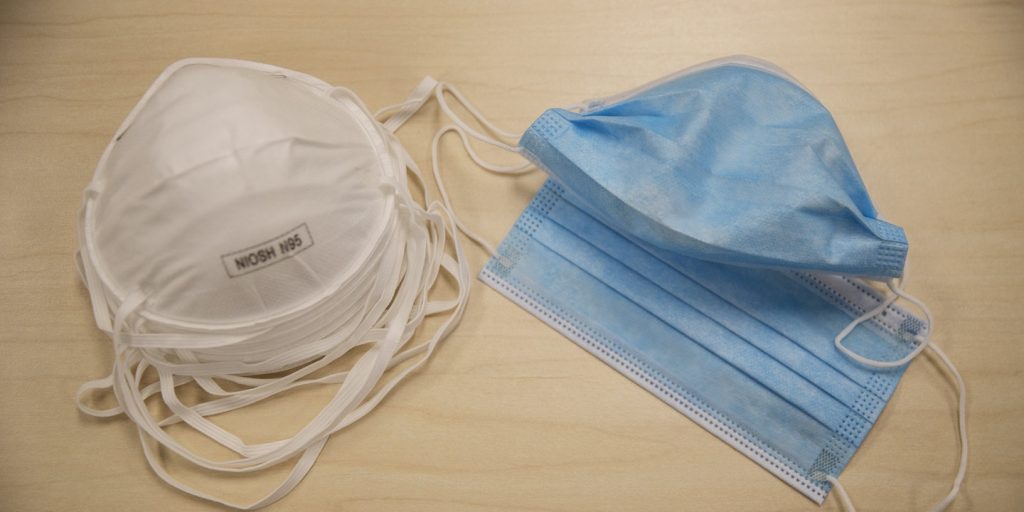
The first modern respirators were also developed in the early 1900s. The impetus for their development derived from the need to protect miners from hazardous dusts and gases, soldiers from chemical warfare agents, and firefighters from smoke and carbon monoxide. In 1919, the U.S. Bureau of Mines published the first respirator performance standards for self-contained breathing apparatus for use in mines and for gas masks for use by soldiers against chemical warfare agents. Today respirators are found in a broad range of workplaces. Their use in healthcare settings dates to the 1990s in response to concerns about employee exposures to drug-resistant tuberculosis. Healthcare worker illnesses and deaths during outbreaks of severe acute respiratory syndrome (SARS) in the early 2000s led to renewed attention to the use of respirators for some infectious respiratory diseases. Most recently, planning efforts for pandemic influenza in 2006-07 led to considerable discussion about the role of small particle inhalation in disease transmission and the use of respirators to protect healthcare personnel from airborne influenza particles. A listing of all NIOSH-approved disposable, or filtering facepiece, respiratorsis available. NIOSH also maintains a database of all NIOSH-approved respirators regardless of respirator type—the Certified Equipment List.
Whether the goal is to prevent the outward escape of user-generated aerosols or the inward transport of hazardous airborne particles, there are two important aspects of performance. First, the filter must be able to capture the full range of hazardous particles, typically within a wide range of sizes (<1 to >100 µm) over a range of airflow (approximately 10 to 100 L/min). Second, leakage must be prevented at the boundary of the facepiece and the face. However, it is not possible to assure the latter—good face seal performance—without first ensuring a well-functioning filter.
Filter Performance
The filters used in modern surgical masks and respirators are considered “fibrous” in nature—constructed from flat, nonwoven mats of fine fibers. Fiber diameter, porosity (the ratio of open space to fibers) and filter thickness all play a role in how well a filter collects particles. In all fibrous filters, three “mechanical” collection mechanisms operate to capture particles: inertial impaction, interception, and diffusion. Inertial impaction and interception are the mechanisms responsible for collecting larger particles, while diffusion is the mechanism responsible for collecting smaller particles. In some fibrous filters constructed from charged fibers, an additional mechanism of electrostatic attraction also operates. This mechanism aids in the collection of both larger and smaller particle sizes. This latter mechanism is very important to filtering facepiece respirator filters that meet the stringent NIOSH filter efficiency and breathing resistance requirements because it enhances particle collection without increasing breathing resistance.
How do filters collect particles?
These capture, or filtration, mechanisms are described as follows:
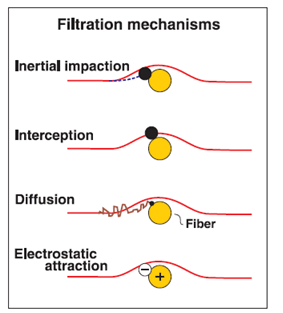
- Inertial impaction: With this mechanism, particles having too much inertia due to size or mass cannot follow the airstream as it is diverted around a filter fiber. This mechanism is responsible for collecting larger particles.
- Interception: As particles pass close to a filter fiber, they may be intercepted by the fiber. Again, this mechanism is responsible for collecting larger particles.
- Diffusion: Small particles are constantly bombarded by air molecules, which causes them to deviate from the airstream and come into contact with a filter fiber. This mechanism is responsible for collecting smaller particles.
- Electrostatic attraction: Oppositely charged particles are attracted to a charged fiber. This collection mechanism does not favor a certain particle size.
In all cases, once a particle comes in contact with a filter fiber, it is removed from the airstream and strongly held by molecular attractive forces. It is very difficult for such particles to be removed once they are collected. As seen in Figure 2, there is a particle size at which none of the “mechanical” collection mechanisms (interception, impaction, or diffusion) is particularly effective. This “most penetrating particle size” (MPPS) marks the best point at which to measure filter performance. If the filter demonstrates a high level of performance at the MPPS, then particles both smaller AND larger will be collected with even higher performance.
This is perhaps the most misunderstood aspect of filter performance and bears repeating. Filters do NOT act as sieves. One of the best tests of a filter’s performance involves measuring particle collection at its most penetrating particle size, which ensures better performance for larger and smaller particles. Further, the filter’s collection efficiency is a function of the size of the particles, and is not dependent on whether they are bioaerosols or inert particles.
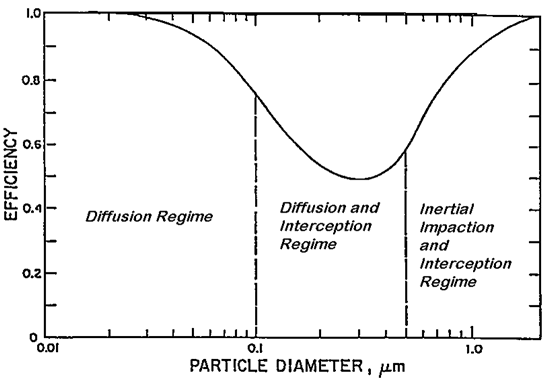
How are surgical masks and respirator filters tested?
Respirator filters must meet stringent certification tests (42 CFR Part 84) established by NIOSH. The NIOSH tests use what are considered “worst case” parameters, including:
- A sodium chloride (for N-series filters) or a dioctyl phthalate oil (for R- and P-series filters) test aerosol with a mass median aerodynamic diameter particle of about 0.3 µm, which is in the MPPS-range for most filters
- Airflow rate of 85 L/min, which represents a moderately-high work rate
- Conditioning at 85% relative humidity and 38°C for 24 hours prior to testing
- An initial breathing resistance (resistance to airflow) not exceeding 35 mm water column* height pressure and initial exhalation resistance not exceeding 25 mm water column height pressure
- A charge-neutralized aerosol
- Aerosol loading conducted to a minimum of 200 mg, which represents a very high workplace exposure
- The filter efficiency cannot fall below the certification class level at any time during the NIOSH certification tests
* Millimeters (mm) of water column is a unit for pressure measurement of small pressure differences. It is defined as the pressure exerted by a column of water of 1 millimeter in height at defined conditions, for example 39°F (4°C) at standard gravity.
As a result of these stringent performance parameters, fiber diameters, porosity, and filter thicknesses of all particulate filters used in NIOSH-certified respirators, including N95s, are designed and engineered to provide very high levels of particle collection efficiencies at their MPPS.
Manufacturers of surgical masks, on the other hand, must demonstrate that their product is at least as good as a mask already on the market to obtain “clearance” for marketing. Manufacturers may choose from filter tests using a biological organism aerosol at an airflow of 28 L/min (bacterial filtration efficiency) or an aerosol of 0.1 µm latex spheres and a velocity ranging from 0.5 to 25 cm/sec (particulate filtration efficiency). It is important to note that the Food and Drug Administration specifies that the latex sphere aerosol must not be charge-neutralized.
The generation of the test aerosol can impart a charge on a higher percentage of the aerosolized particles than may normally be expected in workplace exposures. A charge-neutralized test aerosol, like those used in the NIOSH tests, has the charges on the aerosolized particles reduced to an equilibrium condition. Therefore, higher filter efficiency values than would be expected with the use of charge-neutralized aerosols may result due to the collection of charged particles by the filters’ electrostatic attraction properties. Additionally, allowing the manufacturer to select from a range of air velocity means that the test results can be easily manipulated. In general, particles are collected with higher efficiency at lower velocity through a filter.
Both of these aspects yield a test that is not necessarily “worst case” for a surgical mask filter. Because the performance parameters for surgical masks are less stringent than those required for filters used in NIOSH-certified respirators, the fiber diameters, porosity, and filter thicknesses found in surgical masks are designed with significantly lower levels of particle collection efficiencies at their MPPS.
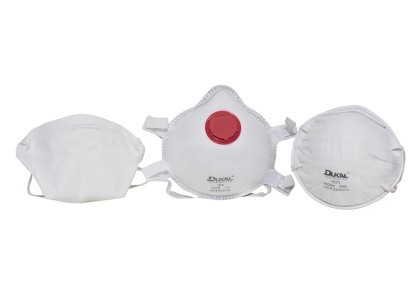
How do surgical mask and respirator filters perform?
Respirator filters that collect at least 95% of the challenge aerosol are given a 95 rating. Those that collect at least 99% receive a “99” rating. And those that collect at least 99.97% (essentially 100%) receive a “100” rating. Respirator filters are rated as N, R, or P for their level of protection against oil aerosols. This rating is important in industry because some industrial oils can remove electrostatic charges from the filter media, thereby degrading (reducing) the filter efficiency performance. Respirators are rated “N” if they are not resistant to oil, “R” if somewhat resistant to oil, and “P” if strongly resistant (oil proof). Thus, there are nine types of particulate respirator filters:
- N95, N-99, and N-100
- R-95, R-99, and R-100
- P-95, P-99, and P-100
Respirator filters are tested by NIOSH at the time of application and periodically afterward to ensure that they continue to meet the certification test criteria. The FDA does not perform an independent evaluation of surgical mask filter performance, nor does it publish manufacturers’ test results. In many cases it is difficult to find information about the filter test results for FDA-cleared surgical masks. The class of FDA-cleared surgical masks known as Surgical N95 Respirators is the one clear exception to this uncertainty of filter performance. This is the only type of surgical mask that includes evaluation to the stringent NIOSH standards. All members of this class of surgical masks have been approved by NIOSH as N95 respirators prior to their clearance by the FDA as surgical masks. The FDA, in part, accepts the NIOSH filter efficiency and breathing resistance test results as exceeding the usual surgical mask requirements.
In studies comparing the performance of surgical mask filters using a standardized airflow, filter performance has been shown to be highly variable. Collection efficiency of surgical mask filters can range from less than 10% to nearly 90% for different manufacturers’ masks when measured using the test parameters for NIOSH certification. Published results on the FDA-required tests (if available) are not predictive of their performance in these studies.
It is important to keep in mind that overall performance of any facepiece for particulate filtering depends, first, on good filter performance. A facepiece or mask that fits well to the face but has a poor filter will not be able to provide a high level of protection.
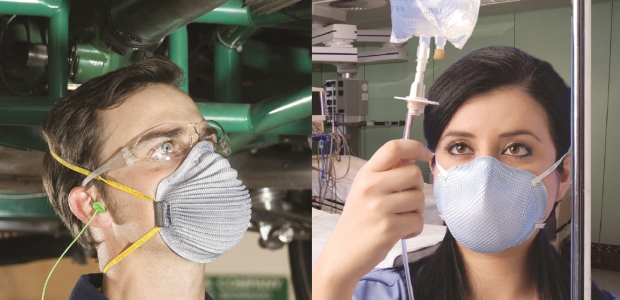
Respirator and Surgical Mask Fit
Because respirator filters must meet stringent certification requirements, they will always demonstrate a very high level of collection efficiency for the broad range of aerosols encountered in workplaces. There has been some recent concern that respirator filters will not collect nano-sized particles, but research has demonstrated that such particles are collected with efficiencies that meet NIOSH standards. This is not surprising, because NIOSH tests employ small, charge-neutralized, relatively monodisperse aerosol particles and a high airflow.
Thus, the most important aspect of a NIOSH-certified respirator’s performance will be how well it fits to the face and minimizes the degree of leakage around the facepiece. This must be measured for each individual and their selected respirator. Selecting the right respirator for a particular workplace exposure depends largely on selecting the right level of protection.
Respirator fit depends on two important design characteristics:
- Whether the respirator operates in a “negative pressure” or “positive pressure” mode
- The type of facepiece and degree of coverage on the face
Respirators that operate in a “negative pressure” mode require the wearer to draw air through an air-cleaning device (filter or chemical cartridge) into the facepiece, which creates a pressure inside the respirator that is negative in comparison to that outside the facepiece. A “positive pressure” respirator, on the other hand, pushes clean air into the facepiece through the use of a fan or compressor, creating a positive pressure inside the facepiece when compared to the outside. Negative pressure respirators inherently offer less protection than positive pressure respirators, because inward leakage occurs more easily in the former.
The facepiece design is also very important—some designs fit on the face better than others. It is more difficult to fit a half-facepiece respirator (one that covers the mouth and nose only) than a full-facepiece respirator (one that also covers the eyes). The nose and chin are the most difficult facial features on which to establish a tight fit. The fit of a hood, helmet or “loose-fitting” facepiece is highly dependent on the specific design and configuration. More details on the different classes of respirators and their levels of protection, can be found on the NIOSH respirator topic page and the OSHA Respiratory Protection Standard
Because fit is so important, NIOSH recommends and OSHA requires that each respirator wearer receive an initial fit test and annual fit tests thereafter. It is not possible to predict how well a respirator will fit on a particular face, even for respirators that fit well on a broad range of facial sizes. The FDA does not recommend or require any test of fit for surgical masks. A very limited number of published studies are available on this aspect of surgical mask performance. Three clinical studies conducted in the 1980s and 90s found no difference in surgical infection rates when staff did not wear surgical masks.1, 2, 3
A recent laboratory study of five surgical masks with “good” filters found that 80–100% of subjects failed an OSHA-accepted qualitative fit test using Bitrex (a bitter tasting aerosol) and quantitative fit factors ranged from 4–8 (12–25% leakage) using a TSI Portacount.4 In contrast, the least protective type of respirator (negative pressure half mask) must have a fit factor (outside particle concentration divided by inside concentration) of at least 100 (1% leakage).
NIOSH would like to hear from you regarding your experiences working with NIOSH-approved respirators and FDA-cleared surgical masks. For example, are there user needs for increased comfort and wearability that NIOSH could help address? Do users feel that exhalation valves on disposable, filtering facepiece impact the wearer’s ability to successfully perform a user seal check? Are there certain aspects of filtering facepiece respirator design that could be improved for better fit? How would you compare the comfort and wearability of surgical masks and filtering facepiece respirators?
Additionally, the NIOSH Respirator Trusted-Source Information Page can help users identify NIOSH-approved respirators and learn how to use and obtain these products.
Dr. Brosseau is a faculty member in the University of Minnesota’s School of Public Health whose research focuses on the performance of respiratory protection, measurement of aerosols, and assessment of workplace exposures to hazardous materials and wastes. Dr. Brosseau was Chair of the ACGIH Threshold Limit Values for Chemical Substances Committee from 1995–2005 and is currently Vice Chair Elect of ACGIH.
Mr. Berry Ann is the Deputy Director of the NIOSH National Personal Protective Technology Laboratory. He has more than 15 years experience working in respirator certification and PPT issues at NIOSH.

